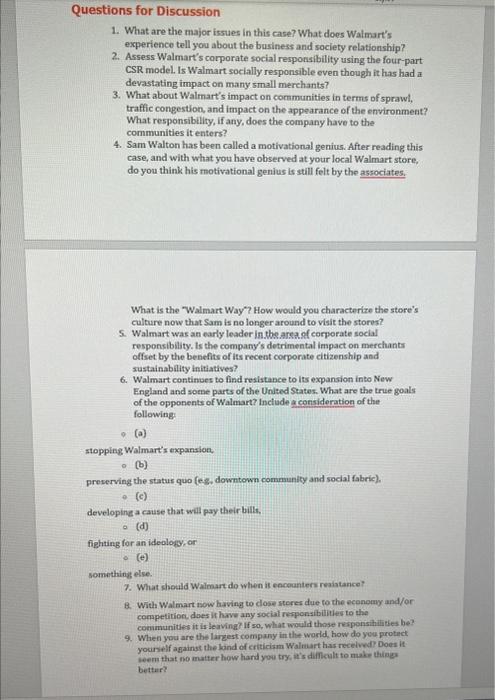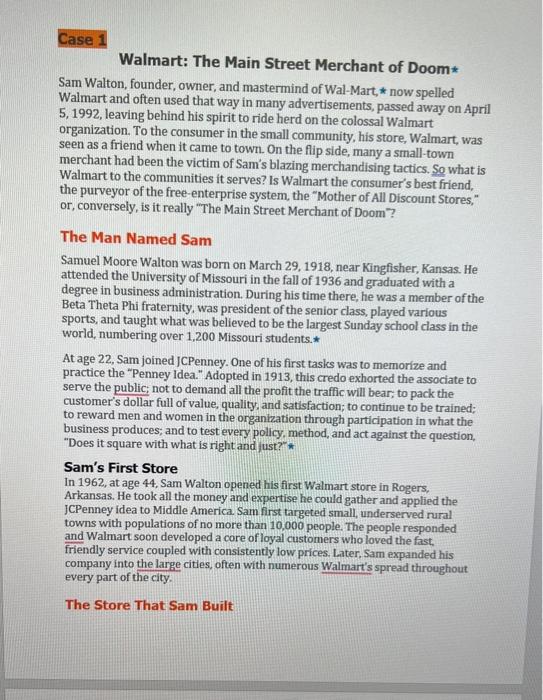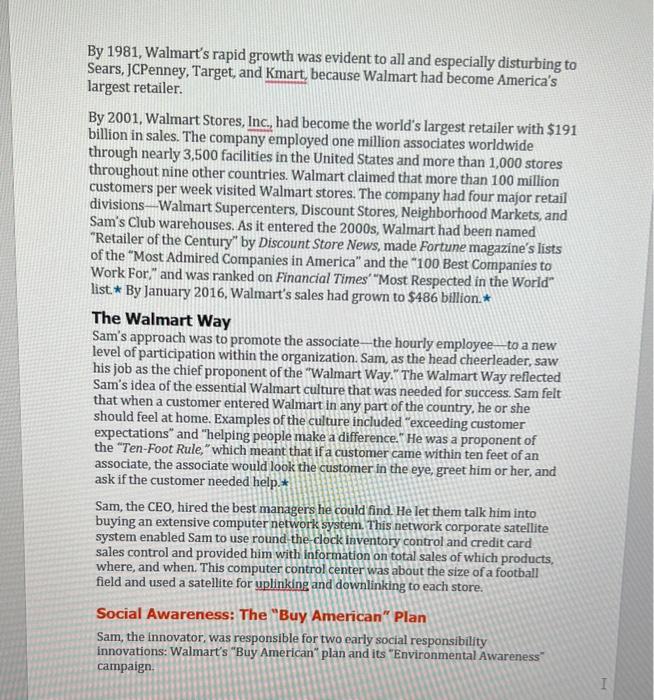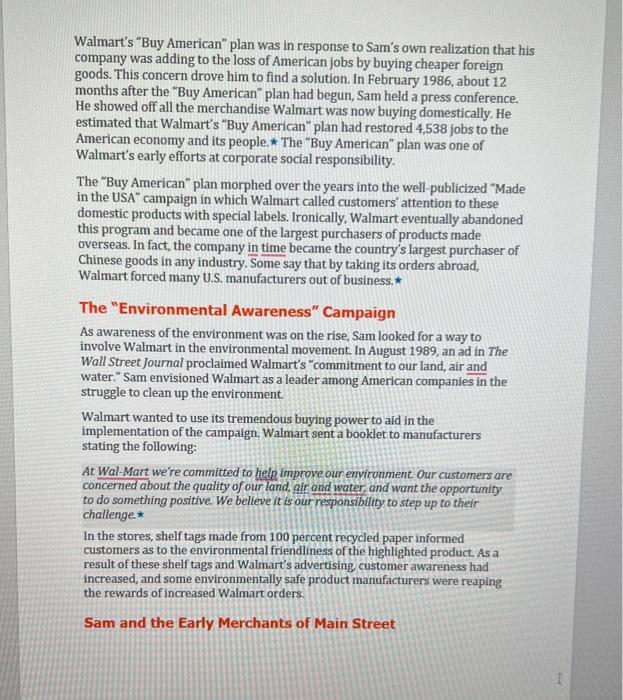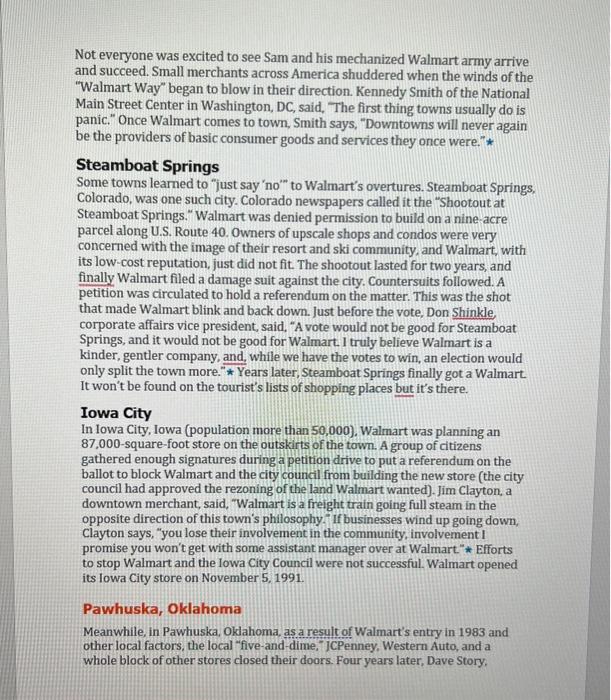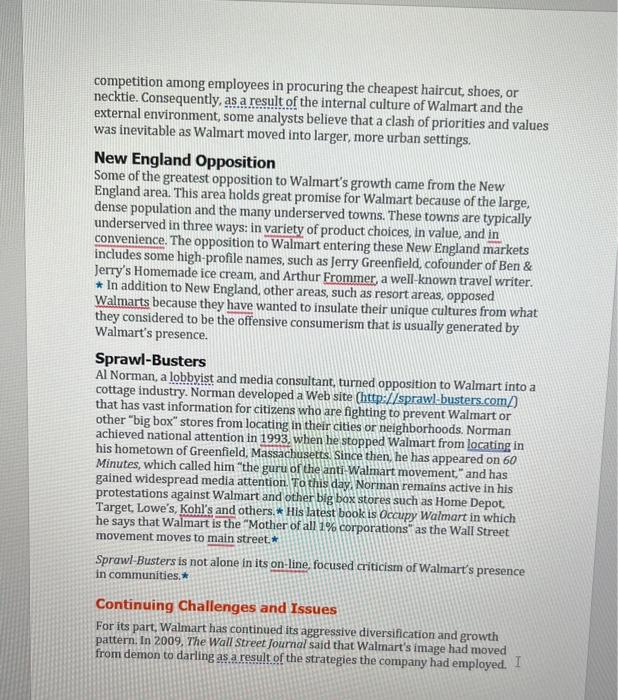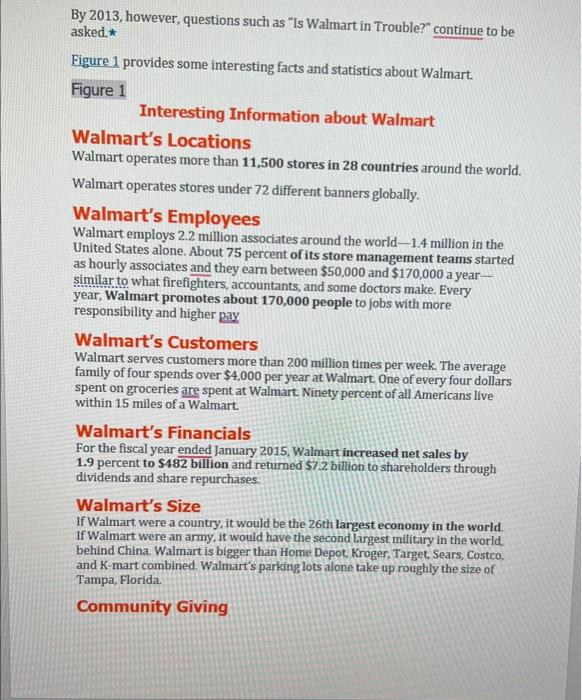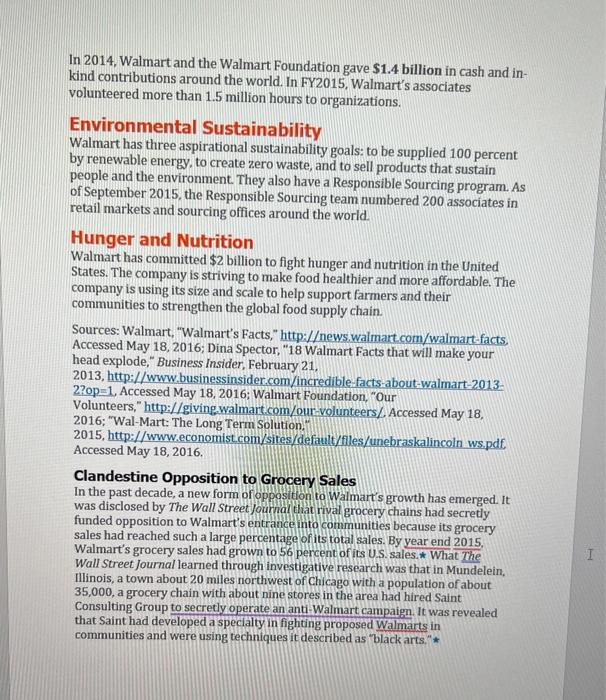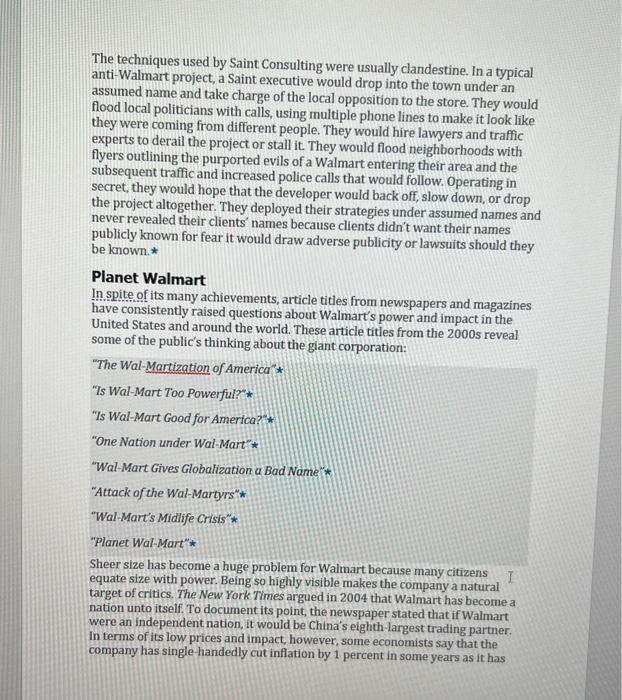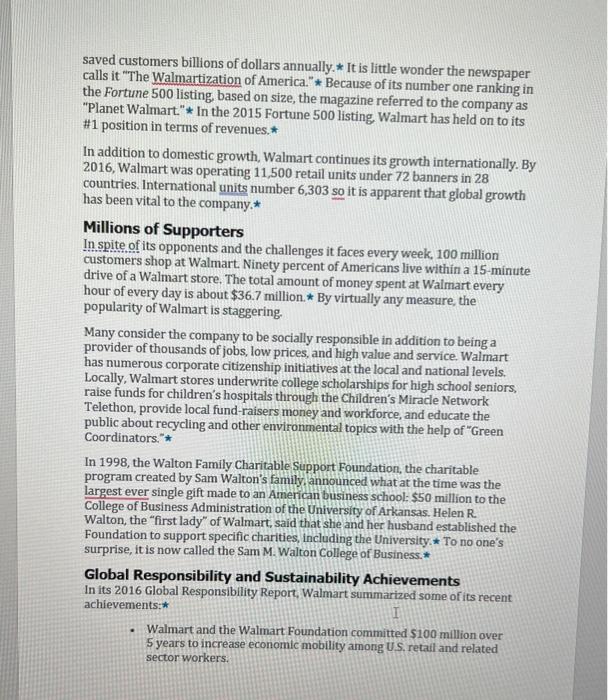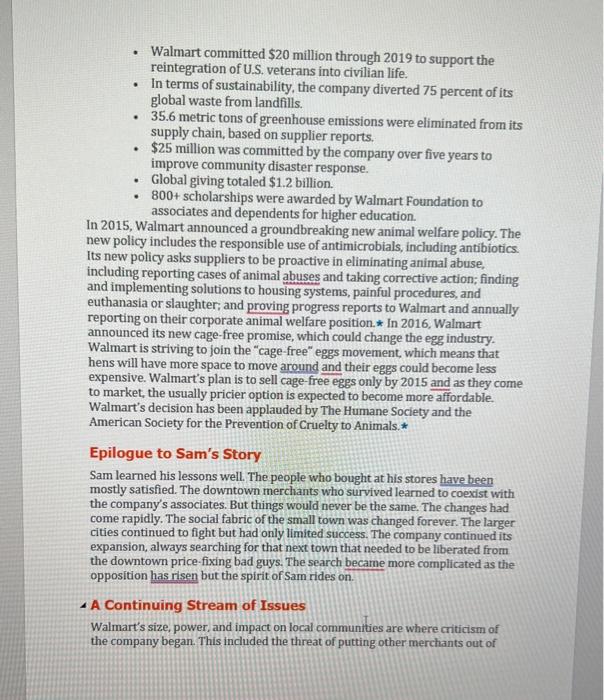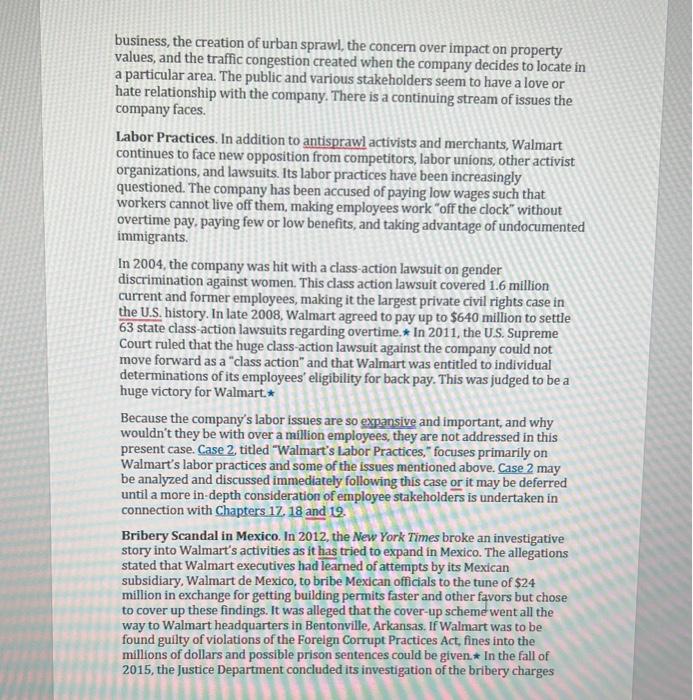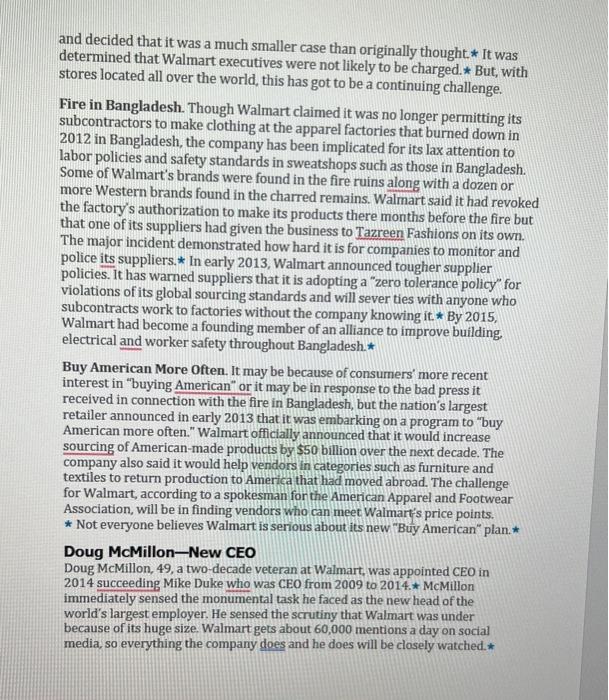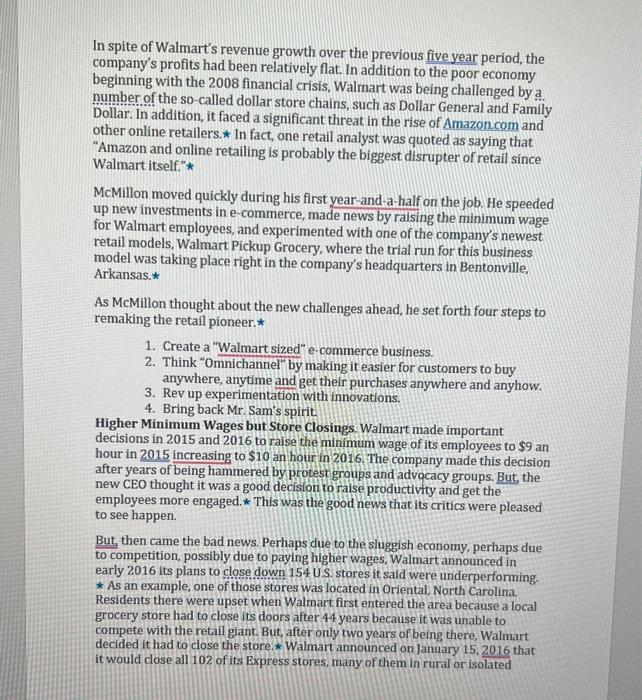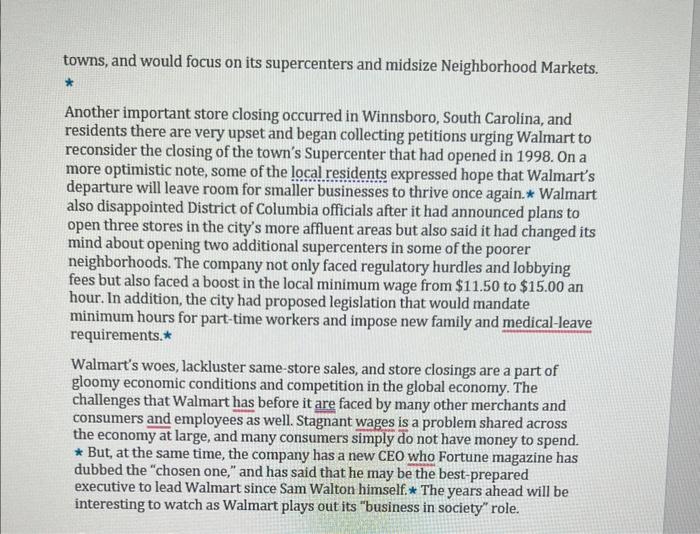Questions for Discussion 1. What are the major issues in this case? What does Walmart's experience tell you about the business and society relationship? 2. Assess Walmart's corporate social responsibility using the four-part CSR model. Is Walmart socially responsible even though it has had a devastating impact on many small merchants? 3. What about Walmart's impact on communities in terms of sprawl, traffic congestion, and impact on the appearance of the environment? What responsibility, if any, does the company have to the communities it enters? 4. Sam Walton has been called a motivational genius. After reading this case, and with what you have observed at your local Walmart store, do you think his motivational genius is still felt by the associates. What is the "Walmart Way"? How would you characterize the store's culture now that Sam is no longer around to visit the stores? 5. Walmart was an early leader in the area of corporate social responsibility. Is the company's detrimental impact on merchants offset by the benefits of its recent corporate citizenship and sustainability initiatives? 6. Walmart continves to ind resistance to its expansion into New England and soene parts of the United States. What are the true goals of the opponents of Walmart? Inctude a consideration of the following: (a) stopping Walmart's expansion: (b) preserving the statur quo (eg. downtown commanity and sodal fabric). (c) developing a cause that will pay their bilk, o (d) fighting for an ideolepy, or - (e) something else. 7. What should Waimart do when it enceunters reaiatance? Q. With Walmart now having to dose stores due to the economy and/or cormpetition does is have any social responsibitities to the competitioce does it have any socisi responsibiinter to the 9. When you are the largest company in the world, how do you protect yourself againat the lind of criticism Walmart has received? Does it seem that no matter how hard you try, it's diffealt to make thinge bettur? Case 1 Walmart: The Main Street Merchant of Doom* Sam Walton, founder, owner, and mastermind of Wal-Mart, * now spelled Walmart and often used that way in many advertisements, passed away on April 5,1992 , leaving behind his spirit to ride herd on the colossal Walmart organization. To the consumer in the small community, his store, Walmart, was seen as a friend when it came to town. On the flip side, many a small-town merchant had been the victim of Sam's blazing merchandising tactics. So what is Walmart to the communities it serves? Is Walmart the consumer's best friend, the purveyor of the free-enterprise system, the "Mother of All Discount Stores," or, conversely, is it really "The Main Street Merchant of Doom"? The Man Named Sam Samuel Moore Walton was born on March 29, 1918, near Kingfisher, Kansas. He attended the University of Missouri in the fall of 1936 and graduated with a degree in business administration. During his time there, he was a member of the Beta Theta Phi fraternity, was president of the senior class, played various sports, and taught what was believed to be the largest Sunday school class in the world, numbering over 1,200 Missouri students.* At age 22, Sam joined JCPenney. One of his first tasks was to memorize and practice the "Penney Idea." Adopted in 1913, this credo exhorted the associate to serve the public; not to demand all the profit the traffic will bear; to pack the customer's dollar full of value, quality, and satisfaction; to continue to be trained; to reward men and women in the organization through participation in what the business produces; and to test every policy, method, and act against the question, "Does it square with what is right and just?" * Sam's First Store In 1962, at age 44, Sam Walton opened his first Walmart store in Rogers, Arkansas. He took all the money and expertise he could gather and applied the JCPenney idea to Middle America. Sam first targeted small, underserved rural towns with populations of no more than 10,000 people. The people responded and Walmart soon developed a core of loyal customers who loved the fast, friendly service coupled with consistently low prices. Later, Sam expanded his company into the large citles, often with numerous Walmart's spread throughout every part of the city. The Store That Sam Built By 1981, Walmart's rapid growth was evident to all and especially disturbing to Sears, JCPenney, Target, and Kmart, because Walmart had become America's largest retailer. By 2001, Walmart Stores, Inc., had become the world's largest retailer with $191 billion in sales. The company employed one million associates worldwide through nearly 3,500 facilities in the United States and more than 1,000 stores throughout nine other countries. Walmart claimed that more than 100 million customers per week visited Walmart stores. The company had four major retail divisions-Walmart Supercenters, Discount Stores, Neighborhood Markets, and Sam's Club warehouses. As it entered the 2000 s, Walmart had been named "Retailer of the Century" by Discount Store News, made Fortune magazine's lists of the "Most Admired Companies in America" and the "100 Best Companies to Work For," and was ranked on Financial Times' "Most Respected in the World" list * By January 2016, Walmart's sales had grown to $486 billion * The Walmart Way Sam's approach was to promote the associate - the hourly employee to a new level of participation within the organization. Sam, as the head cheerleader, saw his job as the chief proponent of the "Walmart Way." The Walmart Way reflected Sam's idea of the essential Walmart culture that was needed for success. Sam felt that when a customer entered Walmart in any part of the country, he or she should feel at home. Examples of the culture included "exceeding customer expectations" and "helping people make a difference." He was a proponent of the "Ten-Foot Rule," which meant that if a customer came within ten feet of an associate, the associate would look the customer in the eye, greet him or her, and ask if the customer needed help.* Sam, the CEO, hired the best managers he could find. He let them talk him into buying an extensive computer network system. This network corporate satellite system enabled Sam to use round the-clock inventory control and credit card sales control and provided him with information on total sales of which products, where, and when. This computer control center was about the size of a football field and used a satellite for uplinking and downlinking to each store. Social Awareness: The "Buy American" Plan Sam, the innovator, was responsible for two early social responsibility innovations: Walmart's "Buy American" plan and its "Environmental Awareness" campaign. Walmart's "Buy American" plan was in response to Sam's own realization that his company was adding to the loss of American jobs by buying cheaper foreign goods. This concern drove him to find a solution. In February 1986, about 12 months after the "Buy American" plan had begun, Sam held a press conference. He showed off all the merchandise Walmart was now buying domestically. He estimated that Walmart's "Buy American" plan had restored 4,538 jobs to the American economy and its people.* The "Buy American" plan was one of Walmart's early efforts at corporate social responsibility. The "Buy American" plan morphed over the years into the well-publicized "Made in the USA" campaign in which Walmart called customers' attention to these domestic products with special labels. Ironically. Walmart eventually abandoned this program and became one of the largest purchasers of products made overseas. In fact, the company in time became the country's largest purchaser of Chinese goods in any industry. Some say that by taking its orders abroad, Walmart forced many U.S, manufacturers out of business. * The "Environmental Awareness" Campaign As awareness of the environment was on the rise, Sam looked for a way to involve Walmart in the environmental movement. In August 1989, an ad in The Wall Street Journal proclaimed Walmart's "commitment to our land, air and water." Sam envisioned Walmart as a leader among American companies in the struggle to clean up the environment. Walmart wanted to use its tremendous buying power to aid in the implementation of the campaign. Walmart sent a booklet to manufacturers stating the following: At Wal-Mart we're committed to help improve our emironment. Our customers are concerned about the quality of our land, air and water, and want the opportunity to do something positive. We believe it is our responsibility to step up to their challenge * In the stores, shelf tags made from 100 percent recycled paper informed customers as to the environmental friendliness of the highlighted product. As a result of these shelf tags and Walmart's advertising, customer awareness had increased, and some environmentally safe product manufacturers were reaping the rewards of increased Walmart orders. Sam and the Early Merchants of Main Street Not everyone was excited to see Sam and his mechanized Walmart army arrive and succeed. Small merchants across America shuddered when the winds of the "Walmart Way" began to blow in their direction. Kennedy Smith of the National Main Street Center in Washington, DC, said, The first thing towns usually do is panic." Once Walmart comes to town, Smith says, "Downtowns will never again be the providers of basic consumer goods and services they once were." * Steamboat Springs Some towns learned to "just say 'no" to Walmart's overtures. Steamboat Springs, Colorado, was one such city. Colorado newspapers called it the "Shootout at Steamboat Springs." Walmart was denied permission to build on a nine-acre parcel along U.S. Route 40. Owners of upscale shops and condos were very concerned with the image of their resort and ski community, and Walmart, with its low-cost reputation, just did not fit. The shootout lasted for two years, and finally Walmart filed a damage suit against the city. Countersuits followed. A petition was circulated to hold a referendum on the matter. This was the shot that made Walmart blink and back down. Just before the vote, Don Shinkle, corporate affairs vice president, said, "A vote would not be good for Steamboat Springs, and it would not be good for Walmart. I truly believe Walmart is a kinder, gentler company, and, while we have the votes to win, an election would only split the town more." * Years later, Steamboat Springs finally got a Walmart. It won't be found on the tourist's lists of shopping places but it's there. Iowa City In Iowa City, Iowa (population more than 50,000 ). Walmart was planning an 87,000-square-foot store on the outskirts of the town. A group of citizens gathered enough signatures during a petition drive to put a referendum on the ballot to block Walmart and the city council from building the new store (the city council had approved the rezoning of the land Walmart wanted). Jim Clayton, a downtown merchant, said, "Walmart is a freight train going full steam in the opposite direction of this town's philosophy. "If businesses wind up going down, Clayton says, "you lose their involvement in the community, involvement 1 promise you won't get with some assistant manager over at Walmart" * Efforts to stop Walmart and the lowa City Council were not successful. Walmart opened its Iowa City store on November 5, 1991. Pawhuska, Oklahoma Meanwhile, in Pawhuska, Oklahoma, as a result of Walmart's entry in 1983 and other local factors, the local "five-and-dime," ICPenney, Western Auto, and a whole block of other stores closed their doors. Four years later, Dave Story, general manager of the local Pawhuska Daily Journal Capital, wrote that Walmart was a "billion-dollar parasite" and a "national retail ogre." * Walmart managers have become very active in Pawhuska and surrounding communities since that time. A conversation with the editor of the Pawhuska paper, Jody Smith, and her advertising editor, Suzy Burns, revealed that Walmart sponsored the local rodeo, gave gloves to the local coat drive, and was involved with the local cerebral palsy and multiple sclerosis fund-raisers. On the other hand, Fred Wright, former owner of a TV and record store, said, "Walmart really craters a little town's downtown." * Opposition to Walmart Gets Organized By the 1990s, there were dozens of organized groups actively opposing Walmart's expansion.* Some of these groups were and still are run by social activists who are reliving the 1960 s and 1970 s. Instead of protesting the Vietnam War, nuclear proliferation, or the destruction of the environment, they turned their efforts to Walmart specifically and capitalism in general. One of these activists, Paul Glover, who was an antiwar organizer, defined Walmart as the epitome of capitalism, which he despises. For Glover and others, Walmart stands for "everything they dislike about American society -mindless consumerism. paved landscapes, and homogenization of community identity."* Boulder, Colorado Opposition In Boulder, Colorado, Walmart tried to counter these allegations by proposing a "green" store. Steven Lane, Walmart's real estate manager, said that a "green store" would be built that would be environmentally friendly, with a solarpowered sign out front and everything, His efforts were trumped by Spencer Havlick, an organizer of the first Earth Day in 1970, suggesting that the entire store be powered by solar energy. Mr. Lane did not respond. * Protest organizers united against the spread of the "Walmart Way" differ from the downtown merchants in that these protesters have no financial stake though they still regard themselves as stakeholders. These activists attack Walmart on a higher, philosophical plane. The accusations ring with a tone of argument that was made by other activists protesting polluting industries (e.g. the coal, nuclear, and chemical industries). These activists accuse Walmart of "stripmining" towns and communities of their culture and values. One possible root of this culture clash may be attributed to the unique aspects of the internal corporate culture at Walmart's headquarters. This is a place where competition for the reputation as the "cheapest" was practiced. An example is the competition among employees in procuring the cheapest haircut, shoes, or necktie. Consequently, as a result of the internal culture of Walmart and the external environment, some analysts believe that a clash of priorities and values was inevitable as Walmart moved into larger, more urban settings. New England Opposition Some of the greatest opposition to Walmart's growth came from the New England area. This area holds great promise for Walmart because of the large, dense population and the many underserved towns. These towns are typically underserved in three ways: in variety of product choices, in value, and in convenience. The opposition to Walmart entering these New England markets includes some high-profile names, such as Jerry Greenfield, cofounder of Ben \& Jerry's Homemade ice cream, and Arthur Frommer, a well-known travel writer. * In addition to New England, other areas, such as resort areas, opposed Walmarts because they have wanted to insulate their unique cultures from what they considered to be the offensive consumerism that is usually generated by Walmart's presence. Sprawl-Busters Al Norman, a lobbyist and media consultant, turned opposition to Walmart into a cottage industry. Norman developed a Web site (http://sprawl-busters.com/) that has vast information for citizens who are fighting to prevent Walmart or other "big box" stores from locating in their cities or neighborhoods. Norman achieved national attention in 1993 , when he stopped Walmart from locating in his hometown of Greenfield, Massachusetts. Since then, he has appeared on 60 Minutes, which called him "the guru of the anti-Walmart movement," and has gained widespread media attention. To this day. Norman remains active in his protestations against Walmart and other big box stores such as Home Depot. Target, Lowe's, Kohl's and others. * His latest book is Occupy Walmart in which he says that Walmart is the "Mother of all 1% corporations" as the Wall Street movement moves to main street * Sprawl-Busters is not alone in its on-line, focused criticism of Walmart's presence in communities Continuing Challenges and Issues For its part, Walmart has continued its aggressive diversification and growth pattern. In 2009. The Wall Street Journal said that Walmart's image had moved from demon to darling as a result of the strategies the company had employed. I By 2013 , however, questions such as "Is Walmart in Trouble?" continue to be asked.* Figure 1 provides some interesting facts and statistics about Walmart. Figure 1 Interesting Information about Walmart Walmart's Locations Walmart operates more than 11,500 stores in 28 countries around the world. Walmart operates stores under 72 different banners globally. Walmart's Employees Walmart employs 2.2 million associates around the world -1.4 million in the United States alone. About 75 percent of its store management teams started as hourly associates and they earn between $50,000 and $170,000 a year similar to what firefighters, accountants, and some doctors make. Every year, Walmart promotes about 170,000 people to jobs with more responsibility and higher pay Walmart's Customers Walmart serves customers more than 200 million times per week. The average family of four spends over $4,000 per year at Walmart One of every four dollars spent on groceries are spent at Walmart Ninety percent of all Americans live within 15 miles of a Walmart. Walmart's Financials For the fiscal year ended January 2015, Walmart increased net sales by 1.9 percent to $482 billion and returned $7.2 billion to shareholders through dividends and share repurchases. Walmart's Size If Walmart were a country, it would be the 26 th largest economy in the world. If Walmart were an army, it would have the second largest military in the world, behind China. Walmart is bigger than Home Depot. Kroger, Target, Sears, Costco. and K-mart combined. Waimart's parking lots alone take up roughly the size of Tampa, Florida. Community Giving In 2014, Walmart and the Walmart Foundation gave $1.4 billion in cash and inkind contributions around the world. In FY2015, Walmart's associates volunteered more than 1.5 million hours to organizations. Environmental Sustainability Walmart has three aspirational sustainability goals: to be supplied 100 percent by renewable energy, to create zero waste, and to sell products that sustain people and the environment. They also have a Responsible Sourcing program. As of September 2015, the Responsible Sourcing team numbered 200 associates in retail markets and sourcing offices around the world. Hunger and Nutrition Walmart has committed $2 billion to fight hunger and nutrition in the United States. The company is striving to make food healthier and more affordable. The company is using its size and scale to help support farmers and their communities to strengthen the global food supply chain. Sources: Walmart, "Walmart's Facts," http:/ews. walmartcom/walmart-facts, Accessed May 18, 2016; Dina Spector, "18 Walmart Facts that will make your head explode," Business Insider, February 21. 2013, httpi//www.businessinsider.com/incredible-facts-about-walmart-2013. 2?op =1. Accessed May 18, 2016; Walmart Foundation, "Our Volunteers," http://givingwalmartcom/our-volunteers/. Accessed May 18 , 2016: "Wal-Mart: The Long Term Solution." 2015, http://www.economistcom/sites/default/files/unebraskalincoln ws.pdt. Accessed May 18, 2016. Clandestine Opposition to Grocery Sales In the past decade, a new form of opposition to Walmart's growth has emerged. it was disclosed by The Wall Street journalthith rival grocery chains had secretly funded opposition to Walmart's entrance into communities because its grocery sales had reached such a large percentage of its total sales. By year end 2015 . Walmart's grocery sales had grown to 56 percent of its U.S. sales. * What The Wall Street Journal learned through investigative research was that in Mundelein, Illinois, a town about 20 miles northwest of Chicago with a population of about 35,000 , a grocery chain with about nine stores in the area had hired Saint Consulting Group to secretly operate an anti-Walmart campaign. It was revealed that Saint had developed a specialty in fighting proposed Walmarts in communities and were using techniques it described as black arts."* The techniques used by Saint Consulting were usually clandestine. In a typical anti-Walmart project, a Saint executive would drop into the town under an assumed name and take charge of the local opposition to the store. They would flood local politicians with calls, using multiple phone lines to make it look like they were coming from different people. They would hire lawyers and traffic experts to derail the project or stall it. They would flood neighborhoods with flyers outlining the purported evils of a Walmart entering their area and the subsequent traffic and increased police calls that would follow. Operating in secret, they would hope that the developer would back off, slow down, or drop the project altogether. They deployed their strategies under assumed names and never revealed their clients' names because clients didn't want their names publicly known for fear it would draw adverse publicity or lawsuits should they be known * saved customers billions of dollars annually. * It is little wonder the newspaper calls it "The Walmartization of America." * Because of its number one ranking in the Fortune 500 listing, based on size, the magazine referred to the company as "Planet Walmart." * In the 2015 Fortune 500 listing. Walmart has held on to its \#1 position in terms of revenues, * In addition to domestic growth, Walmart continues its growth internationally. By 2016, Walmart was operating 11,500 retail units under 72 banners in 28 countries. International units number 6,303 so it is apparent that global growth has been vital to the company. * Millions of Supporters In spite of its opponents and the challenges it faces every week, 100 million customers shop at Walmart. Ninety percent of Americans live within a 15 -minute drive of a Walmart store. The total amount of money spent at Waimart every hour of every day is about $36.7 million By virtually any measure, the popularity of Walmart is staggering. Many consider the company to be socially responsible in addition to being a provider of thousands of jobs, low prices, and high value and service. Walmart has numerous corporate citizenship initiatives at the local and national levels. Locally, Walmart stores underwrite college scholarships for high school seniors, raise funds for children's hospitals through the Children's Miracle Network Telethon, provide local fund-raisers money and workforce, and educate the public about recycling and other environmental topics with the help of "Green Coordinators."* In 1998, the Walton Family Charitable Support Foundation, the charitable program created by Sam Waiton's family, announced what at the time was the largest ever single gift made to an American business school: $50 million to the College of Business Administration of the University of Arkansas. Helen R. Walton, the "first lady" of Walmart, said that she and her husband established the Foundation to support specific charities, including the University. * To no one's surprise, it is now called the Sam M. Walton College of Business.* Global Responsibility and Sustainability Achievements In its 2016 Global Responsibility Report, Walmart summarized some of its recent achievements: - Walmart and the Walmart Foundation committed $100 million over 5 years to increase economic mobility among US, retail and related sector workers. - Walmart committed $20 million through 2019 to support the reintegration of U.S. veterans into civilian life. - In terms of sustainability, the company diverted 75 percent of its global waste from landfills. - 35.6 metric tons of greenhouse emissions were eliminated from its supply chain, based on supplier reports. - $25 million was committed by the company over five years to improve community disaster response. - Global giving totaled $1.2 billion. - 800+ scholarships were awarded by Walmart Foundation to associates and dependents for higher education. In 2015, Walmart announced a groundbreaking new animal welfare policy. The new policy includes the responsible use of antimicrobials, including antibiotics. Its new policy asks suppliers to be proactive in eliminating animal abuse, including reporting cases of animal abuses and taking corrective action; finding and implementing solutions to housing systems, painful procedures, and euthanasia or slaughter; and proving progress reports to Walmart and annually reporting on their corporate animal welfare position In 2016, Walmart announced its new cage-free promise, which could change the egg industry. Walmart is striving to join the "cage-free" eggs movement, which means that hens will have more space to move around and their eggs could become less expensive. Walmart's plan is to sell cage-free eggs only by 2015 and as they come to market, the usually pricier option is expected to become more affordable. Walmart's decision has been applauded by The Humane Society and the American Society for the Prevention of Cruelty to Animals. * Epilogue to Sam's Story Sam learned his lessons well. The people who bought at his stores have been mostly satisfied. The downtown merchants who survived learned to coexist with the company's associates. But things would never be the same. The changes had come rapidly. The social fabric of the small town was changed forever. The larger cities continued to fight but had only limited success. The company continued its expansion, always searching for that next town that needed to be liberated from the downtown price-fixing bad guys. The search became more complicated as the opposition has risen but the spirit of Sam rides on. A Continuing Stream of Issues Walmart's size, power, and impact on local communities are where criticism of the company began. This included the threat of putting other merchants out of business, the creation of urban sprawl, the concem over impact on property values, and the traffic congestion created when the company decides to locate in a particular area. The public and various stakeholders seem to have a love or hate relationship with the company. There is a continuing stream of issues the company faces. Labor Practices. In addition to antisprawl activists and merchants, Walmart continues to face new opposition from competitors, labor unions, other activist organizations, and lawsuits. Its labor practices have been increasingly questioned. The company has been accused of paying low wages such that workers cannot live off them, making employees work "off the clock" without overtime pay, paying few or low benefits, and taking advantage of undocumented immigrants. In 2004, the company was hit with a class-action lawsuit on gender discrimination against women. This class action lawsuit covered 1.6 million current and former employees, making it the largest private civil rights case in the U.S. history. In late 2008, Walmart agreed to pay up to $640 million to settle 63 state class-action lawsuits regarding overtime, In 2011, the U.S. Supreme Court ruled that the huge class-action lawsuit against the company could not move forward as a "class action" and that Walmart was entitled to individual determinations of its employees' eligibility for back pay. This was judged to be a huge victory for Walmart * Because the company's labor issues are so expansive and important, and why wouldn't they be with over a million employees, they are not addressed in this present case. Case 2, titled "Walmart's Labor Practices," focuses primarily on Walmart's labor practices and some of the issues mentioned above. Case 2 may be analyzed and discussed immediately following this case or it may be deferred until a more in-depth consideration of employee stakeholders is undertaken in connection with Chapters 17,18 and 19. Bribery Scandal in Mexico. In 2012, the New York Times broke an investigative story into Walmart's activities as it has tried to expand in Mexico. The allegations stated that Walmart executives had learned of attempts by its Mexican subsidiary, Walmart de Mexico, to bribe Mexican officials to the tune of $24 million in exchange for getting building permits faster and other favors but chose to cover up these findings. It was alleged that the cover-up scheme went all the way to Walmart headquarters in Bentonville, Arkansas. If Walmart was to be found guilty of violations of the Forelgn Corrupt Practices Act, fines into the millions of dollars and possible prison sentences could be given In the fall of 2015, the Justice Department concluded its investigation of the bribery charges and decided that it was a much smaller case than originally thought * It was determined that Walmart executives were not likely to be charged. * But, with stores located all over the world, this has got to be a continuing challenge. Fire in Bangladesh. Though Walmart claimed it was no longer permitting its subcontractors to make clothing at the apparel factories that burned down in 2012 in Bangladesh, the company has been implicated for its lax attention to labor policies and safety standards in sweatshops such as those in Bangladesh. Some of Walmart's brands were found in the fire ruins along with a dozen or more Western brands found in the charred remains. Walmart said it had revoked the factory's authorization to make its products there months before the fire but that one of its suppliers had given the business to Tazreen Fashions on its own. The major incident demonstrated how hard it is for companies to monitor and police its suppliers, * In early 2013, Walmart announced tougher supplier policies. It has warned suppliers that it is adopting a "zero tolerance policy" for violations of its global sourcing standards and will sever ties with anyone who subcontracts work to factories without the company knowing it * By 2015 , Walmart had become a founding member of an alliance to improve building, electrical and worker safety throughout Bangladesh * Buy American More Often. It may be because of consumers' more recent interest in "buying American" or it may be in response to the bad press it received in connection with the fire in Bangladesh, but the nation's largest retailer announced in early 2013 that it was embarking on a program to "buy American more often." Walmart officially announced that it would increase sourcing of American-made products by $50 billion over the next decade. The company also said it would help vendors in categories such as furniture and textiles to return production to America that had moved abroad. The challenge for Walmart, according to a spokesman for the American Apparel and Footwear Association, will be in finding vendors who can meet Waimart's price points. * Not everyone believes Walmart is serious about its new "Buy American" plan. * Doug McMillon-New CEO Doug McMillon, 49, a two-decade veteran at Walmart, was appointed CEO in 2014 succeeding Mike Duke who was CEO from 2009 to 2014 * McMillon immediately sensed the monumental task he faced as the new head of the world's largest employer. He sensed the scrutiny that Walmart was under because of its huge size. Walmart gets about 60,000 mentions a day on social media, so everything the company does and he does will be closely watched. * In spite of Walmart's revenue growth over the previous five year period, the company's profits had been relatively flat. In addition to the poor economy beginning with the 2008 financial crisis, Walmart was being challenged by a number of the so-called dollar store chains, such as Dollar General and Family Dollar. In addition, it faced a significant threat in the rise of Amazon.com and other online retailers. * In fact, one retail analyst was quoted as saying that "Amazon and online retailing is probably the biggest disrupter of retail since Walmart itself." * McMillon moved quickly during his first year-and-a-half on the job. He speeded up new investments in e-commerce, made news by raising the minimum wage for Walmart employees, and experimented with one of the company's newest retail models, Walmart Pickup Grocery, where the trial run for this business model was taking place right in the company's headquarters in Bentonville. Arkansas. * As McMillon thought about the new challenges ahead, he set forth four steps to remaking the retail pioneer * 1. Create a "Walmart sized" e-commerce business. 2. Think "Omnichannel" by making it easier for customers to buy anywhere, anytime and get their purchases anywhere and anyhow. 3. Rev up experimentation with innovations. 4. Bring back Mr. Sam's spirit. Higher Minimum Wages but Store Closings. Walmart made important decisions in 2015 and 2016 to raise the minimum wage of its employees to $9 an hour in 2015 increasing to $10 an hour in 2016. The company made this decision after years of being hammered by protest groups and advocacy groups. But, the new CEO thought it was a good decision to raise productivty and get the employees more engaged. * This was the good news that its critics were pleased to see happen. But, then came the bad news. Perhaps due to the sluggish economy, perhaps due to competition, possibly due to paying higher wages, Walmart announced in early 2016 its plans to close down 154 U.S. stores it said were underperforming. * As an example, one of those stores was located in Oriental, North Carolina. Residents there were upset when Walmart first entered the area because a local grocery store had to close its doors after 44 years because it was unable to compete with the retail giant. But, after only two years of being there, Walmart decided it had to close the store. * Walmart announced on January 15, 2016 that it would close all 102 of its Express stores, many of them in rural or isolated towns, and would focus on its supercenters and midsize Neighborhood Markets. Another important store closing occurred in Winnsboro, South Carolina, and residents there are very upset and began collecting petitions urging Walmart to reconsider the closing of the town's Supercenter that had opened in 1998. On a more optimistic note, some of the local residents expressed hope that Walmart's departure will leave room for smaller businesses to thrive once again. Walmart also disappointed District of Columbia officials after it had announced plans to open three stores in the city's more affluent areas but also said it had changed its mind about opening two additional supercenters in some of the poorer neighborhoods. The company not only faced regulatory hurdles and lobbying fees but also faced a boost in the local minimum wage from $11.50 to $15.00 an hour. In addition, the city had proposed legislation that would mandate minimum hours for part-time workers and impose new family and medical-leave requirements. * Walmart's woes, lackluster same-store sales, and store closings are a part of gloomy economic conditions and competition in the global economy. The challenges that Walmart has before it are faced by many other merchants and consumers and employees as well. Stagnant wages is a problem shared across the economy at large, and many consumers simply do not have money to spend. * But, at the same time, the company has a new CEO who Fortune magazine has dubbed the "chosen one," and has said that he may be the best-prepared executive to lead Walmart since Sam Walton himself. The years ahead will be interesting to watch as Walmart plays out its "business in society" role. Questions for Discussion 1. What are the major issues in this case? What does Walmart's experience tell you about the business and society relationship? 2. Assess Walmart's corporate social responsibility using the four-part CSR model. Is Walmart socially responsible even though it has had a devastating impact on many small merchants? 3. What about Walmart's impact on communities in terms of sprawl, traffic congestion, and impact on the appearance of the environment? What responsibility, if any, does the company have to the communities it enters? 4. Sam Walton has been called a motivational genius. After reading this case, and with what you have observed at your local Walmart store, do you think his motivational genius is still felt by the associates. What is the "Walmart Way"? How would you characterize the store's culture now that Sam is no longer around to visit the stores? 5. Walmart was an early leader in the area of corporate social responsibility. Is the company's detrimental impact on merchants offset by the benefits of its recent corporate citizenship and sustainability initiatives? 6. Walmart continves to ind resistance to its expansion into New England and soene parts of the United States. What are the true goals of the opponents of Walmart? Inctude a consideration of the following: (a) stopping Walmart's expansion: (b) preserving the statur quo (eg. downtown commanity and sodal fabric). (c) developing a cause that will pay their bilk, o (d) fighting for an ideolepy, or - (e) something else. 7. What should Waimart do when it enceunters reaiatance? Q. With Walmart now having to dose stores due to the economy and/or cormpetition does is have any social responsibitities to the competitioce does it have any socisi responsibiinter to the 9. When you are the largest company in the world, how do you protect yourself againat the lind of criticism Walmart has received? Does it seem that no matter how hard you try, it's diffealt to make thinge bettur? Case 1 Walmart: The Main Street Merchant of Doom* Sam Walton, founder, owner, and mastermind of Wal-Mart, * now spelled Walmart and often used that way in many advertisements, passed away on April 5,1992 , leaving behind his spirit to ride herd on the colossal Walmart organization. To the consumer in the small community, his store, Walmart, was seen as a friend when it came to town. On the flip side, many a small-town merchant had been the victim of Sam's blazing merchandising tactics. So what is Walmart to the communities it serves? Is Walmart the consumer's best friend, the purveyor of the free-enterprise system, the "Mother of All Discount Stores," or, conversely, is it really "The Main Street Merchant of Doom"? The Man Named Sam Samuel Moore Walton was born on March 29, 1918, near Kingfisher, Kansas. He attended the University of Missouri in the fall of 1936 and graduated with a degree in business administration. During his time there, he was a member of the Beta Theta Phi fraternity, was president of the senior class, played various sports, and taught what was believed to be the largest Sunday school class in the world, numbering over 1,200 Missouri students.* At age 22, Sam joined JCPenney. One of his first tasks was to memorize and practice the "Penney Idea." Adopted in 1913, this credo exhorted the associate to serve the public; not to demand all the profit the traffic will bear; to pack the customer's dollar full of value, quality, and satisfaction; to continue to be trained; to reward men and women in the organization through participation in what the business produces; and to test every policy, method, and act against the question, "Does it square with what is right and just?" * Sam's First Store In 1962, at age 44, Sam Walton opened his first Walmart store in Rogers, Arkansas. He took all the money and expertise he could gather and applied the JCPenney idea to Middle America. Sam first targeted small, underserved rural towns with populations of no more than 10,000 people. The people responded and Walmart soon developed a core of loyal customers who loved the fast, friendly service coupled with consistently low prices. Later, Sam expanded his company into the large citles, often with numerous Walmart's spread throughout every part of the city. The Store That Sam Built By 1981, Walmart's rapid growth was evident to all and especially disturbing to Sears, JCPenney, Target, and Kmart, because Walmart had become America's largest retailer. By 2001, Walmart Stores, Inc., had become the world's largest retailer with $191 billion in sales. The company employed one million associates worldwide through nearly 3,500 facilities in the United States and more than 1,000 stores throughout nine other countries. Walmart claimed that more than 100 million customers per week visited Walmart stores. The company had four major retail divisions-Walmart Supercenters, Discount Stores, Neighborhood Markets, and Sam's Club warehouses. As it entered the 2000 s, Walmart had been named "Retailer of the Century" by Discount Store News, made Fortune magazine's lists of the "Most Admired Companies in America" and the "100 Best Companies to Work For," and was ranked on Financial Times' "Most Respected in the World" list * By January 2016, Walmart's sales had grown to $486 billion * The Walmart Way Sam's approach was to promote the associate - the hourly employee to a new level of participation within the organization. Sam, as the head cheerleader, saw his job as the chief proponent of the "Walmart Way." The Walmart Way reflected Sam's idea of the essential Walmart culture that was needed for success. Sam felt that when a customer entered Walmart in any part of the country, he or she should feel at home. Examples of the culture included "exceeding customer expectations" and "helping people make a difference." He was a proponent of the "Ten-Foot Rule," which meant that if a customer came within ten feet of an associate, the associate would look the customer in the eye, greet him or her, and ask if the customer needed help.* Sam, the CEO, hired the best managers he could find. He let them talk him into buying an extensive computer network system. This network corporate satellite system enabled Sam to use round the-clock inventory control and credit card sales control and provided him with information on total sales of which products, where, and when. This computer control center was about the size of a football field and used a satellite for uplinking and downlinking to each store. Social Awareness: The "Buy American" Plan Sam, the innovator, was responsible for two early social responsibility innovations: Walmart's "Buy American" plan and its "Environmental Awareness" campaign. Walmart's "Buy American" plan was in response to Sam's own realization that his company was adding to the loss of American jobs by buying cheaper foreign goods. This concern drove him to find a solution. In February 1986, about 12 months after the "Buy American" plan had begun, Sam held a press conference. He showed off all the merchandise Walmart was now buying domestically. He estimated that Walmart's "Buy American" plan had restored 4,538 jobs to the American economy and its people.* The "Buy American" plan was one of Walmart's early efforts at corporate social responsibility. The "Buy American" plan morphed over the years into the well-publicized "Made in the USA" campaign in which Walmart called customers' attention to these domestic products with special labels. Ironically. Walmart eventually abandoned this program and became one of the largest purchasers of products made overseas. In fact, the company in time became the country's largest purchaser of Chinese goods in any industry. Some say that by taking its orders abroad, Walmart forced many U.S, manufacturers out of business. * The "Environmental Awareness" Campaign As awareness of the environment was on the rise, Sam looked for a way to involve Walmart in the environmental movement. In August 1989, an ad in The Wall Street Journal proclaimed Walmart's "commitment to our land, air and water." Sam envisioned Walmart as a leader among American companies in the struggle to clean up the environment. Walmart wanted to use its tremendous buying power to aid in the implementation of the campaign. Walmart sent a booklet to manufacturers stating the following: At Wal-Mart we're committed to help improve our emironment. Our customers are concerned about the quality of our land, air and water, and want the opportunity to do something positive. We believe it is our responsibility to step up to their challenge * In the stores, shelf tags made from 100 percent recycled paper informed customers as to the environmental friendliness of the highlighted product. As a result of these shelf tags and Walmart's advertising, customer awareness had increased, and some environmentally safe product manufacturers were reaping the rewards of increased Walmart orders. Sam and the Early Merchants of Main Street Not everyone was excited to see Sam and his mechanized Walmart army arrive and succeed. Small merchants across America shuddered when the winds of the "Walmart Way" began to blow in their direction. Kennedy Smith of the National Main Street Center in Washington, DC, said, The first thing towns usually do is panic." Once Walmart comes to town, Smith says, "Downtowns will never again be the providers of basic consumer goods and services they once were." * Steamboat Springs Some towns learned to "just say 'no" to Walmart's overtures. Steamboat Springs, Colorado, was one such city. Colorado newspapers called it the "Shootout at Steamboat Springs." Walmart was denied permission to build on a nine-acre parcel along U.S. Route 40. Owners of upscale shops and condos were very concerned with the image of their resort and ski community, and Walmart, with its low-cost reputation, just did not fit. The shootout lasted for two years, and finally Walmart filed a damage suit against the city. Countersuits followed. A petition was circulated to hold a referendum on the matter. This was the shot that made Walmart blink and back down. Just before the vote, Don Shinkle, corporate affairs vice president, said, "A vote would not be good for Steamboat Springs, and it would not be good for Walmart. I truly believe Walmart is a kinder, gentler company, and, while we have the votes to win, an election would only split the town more." * Years later, Steamboat Springs finally got a Walmart. It won't be found on the tourist's lists of shopping places but it's there. Iowa City In Iowa City, Iowa (population more than 50,000 ). Walmart was planning an 87,000-square-foot store on the outskirts of the town. A group of citizens gathered enough signatures during a petition drive to put a referendum on the ballot to block Walmart and the city council from building the new store (the city council had approved the rezoning of the land Walmart wanted). Jim Clayton, a downtown merchant, said, "Walmart is a freight train going full steam in the opposite direction of this town's philosophy. "If businesses wind up going down, Clayton says, "you lose their involvement in the community, involvement 1 promise you won't get with some assistant manager over at Walmart" * Efforts to stop Walmart and the lowa City Council were not successful. Walmart opened its Iowa City store on November 5, 1991. Pawhuska, Oklahoma Meanwhile, in Pawhuska, Oklahoma, as a result of Walmart's entry in 1983 and other local factors, the local "five-and-dime," ICPenney, Western Auto, and a whole block of other stores closed their doors. Four years later, Dave Story, general manager of the local Pawhuska Daily Journal Capital, wrote that Walmart was a "billion-dollar parasite" and a "national retail ogre." * Walmart managers have become very active in Pawhuska and surrounding communities since that time. A conversation with the editor of the Pawhuska paper, Jody Smith, and her advertising editor, Suzy Burns, revealed that Walmart sponsored the local rodeo, gave gloves to the local coat drive, and was involved with the local cerebral palsy and multiple sclerosis fund-raisers. On the other hand, Fred Wright, former owner of a TV and record store, said, "Walmart really craters a little town's downtown." * Opposition to Walmart Gets Organized By the 1990s, there were dozens of organized groups actively opposing Walmart's expansion.* Some of these groups were and still are run by social activists who are reliving the 1960 s and 1970 s. Instead of protesting the Vietnam War, nuclear proliferation, or the destruction of the environment, they turned their efforts to Walmart specifically and capitalism in general. One of these activists, Paul Glover, who was an antiwar organizer, defined Walmart as the epitome of capitalism, which he despises. For Glover and others, Walmart stands for "everything they dislike about American society -mindless consumerism. paved landscapes, and homogenization of community identity."* Boulder, Colorado Opposition In Boulder, Colorado, Walmart tried to counter these allegations by proposing a "green" store. Steven Lane, Walmart's real estate manager, said that a "green store" would be built that would be environmentally friendly, with a solarpowered sign out front and everything, His efforts were trumped by Spencer Havlick, an organizer of the first Earth Day in 1970, suggesting that the entire store be powered by solar energy. Mr. Lane did not respond. * Protest organizers united against the spread of the "Walmart Way" differ from the downtown merchants in that these protesters have no financial stake though they still regard themselves as stakeholders. These activists attack Walmart on a higher, philosophical plane. The accusations ring with a tone of argument that was made by other activists protesting polluting industries (e.g. the coal, nuclear, and chemical industries). These activists accuse Walmart of "stripmining" towns and communities of their culture and values. One possible root of this culture clash may be attributed to the unique aspects of the internal corporate culture at Walmart's headquarters. This is a place where competition for the reputation as the "cheapest" was practiced. An example is the competition among employees in procuring the cheapest haircut, shoes, or necktie. Consequently, as a result of the internal culture of Walmart and the external environment, some analysts believe that a clash of priorities and values was inevitable as Walmart moved into larger, more urban settings. New England Opposition Some of the greatest opposition to Walmart's growth came from the New England area. This area holds great promise for Walmart because of the large, dense population and the many underserved towns. These towns are typically underserved in three ways: in variety of product choices, in value, and in convenience. The opposition to Walmart entering these New England markets includes some high-profile names, such as Jerry Greenfield, cofounder of Ben \& Jerry's Homemade ice cream, and Arthur Frommer, a well-known travel writer. * In addition to New England, other areas, such as resort areas, opposed Walmarts because they have wanted to insulate their unique cultures from what they considered to be the offensive consumerism that is usually generated by Walmart's presence. Sprawl-Busters Al Norman, a lobbyist and media consultant, turned opposition to Walmart into a cottage industry. Norman developed a Web site (http://sprawl-busters.com/) that has vast information for citizens who are fighting to prevent Walmart or other "big box" stores from locating in their cities or neighborhoods. Norman achieved national attention in 1993 , when he stopped Walmart from locating in his hometown of Greenfield, Massachusetts. Since then, he has appeared on 60 Minutes, which called him "the guru of the anti-Walmart movement," and has gained widespread media attention. To this day. Norman remains active in his protestations against Walmart and other big box stores such as Home Depot. Target, Lowe's, Kohl's and others. * His latest book is Occupy Walmart in which he says that Walmart is the "Mother of all 1% corporations" as the Wall Street movement moves to main street * Sprawl-Busters is not alone in its on-line, focused criticism of Walmart's presence in communities Continuing Challenges and Issues For its part, Walmart has continued its aggressive diversification and growth pattern. In 2009. The Wall Street Journal said that Walmart's image had moved from demon to darling as a result of the strategies the company had employed. I By 2013 , however, questions such as "Is Walmart in Trouble?" continue to be asked.* Figure 1 provides some interesting facts and statistics about Walmart. Figure 1 Interesting Information about Walmart Walmart's Locations Walmart operates more than 11,500 stores in 28 countries around the world. Walmart operates stores under 72 different banners globally. Walmart's Employees Walmart employs 2.2 million associates around the world -1.4 million in the United States alone. About 75 percent of its store management teams started as hourly associates and they earn between $50,000 and $170,000 a year similar to what firefighters, accountants, and some doctors make. Every year, Walmart promotes about 170,000 people to jobs with more responsibility and higher pay Walmart's Customers Walmart serves customers more than 200 million times per week. The average family of four spends over $4,000 per year at Walmart One of every four dollars spent on groceries are spent at Walmart Ninety percent of all Americans live within 15 miles of a Walmart. Walmart's Financials For the fiscal year ended January 2015, Walmart increased net sales by 1.9 percent to $482 billion and returned $7.2 billion to shareholders through dividends and share repurchases. Walmart's Size If Walmart were a country, it would be the 26 th largest economy in the world. If Walmart were an army, it would have the second largest military in the world, behind China. Walmart is bigger than Home Depot. Kroger, Target, Sears, Costco. and K-mart combined. Waimart's parking lots alone take up roughly the size of Tampa, Florida. Community Giving In 2014, Walmart and the Walmart Foundation gave $1.4 billion in cash and inkind contributions around the world. In FY2015, Walmart's associates volunteered more than 1.5 million hours to organizations. Environmental Sustainability Walmart has three aspirational sustainability goals: to be supplied 100 percent by renewable energy, to create zero waste, and to sell products that sustain people and the environment. They also have a Responsible Sourcing program. As of September 2015, the Responsible Sourcing team numbered 200 associates in retail markets and sourcing offices around the world. Hunger and Nutrition Walmart has committed $2 billion to fight hunger and nutrition in the United States. The company is striving to make food healthier and more affordable. The company is using its size and scale to help support farmers and their communities to strengthen the global food supply chain. Sources: Walmart, "Walmart's Facts," http:/ews. walmartcom/walmart-facts, Accessed May 18, 2016; Dina Spector, "18 Walmart Facts that will make your head explode," Business Insider, February 21. 2013, httpi//www.businessinsider.com/incredible-facts-about-walmart-2013. 2?op =1. Accessed May 18, 2016; Walmart Foundation, "Our Volunteers," http://givingwalmartcom/our-volunteers/. Accessed May 18 , 2016: "Wal-Mart: The Long Term Solution." 2015, http://www.economistcom/sites/default/files/unebraskalincoln ws.pdt. Accessed May 18, 2016. Clandestine Opposition to Grocery Sales In the past decade, a new form of opposition to Walmart's growth has emerged. it was disclosed by The Wall Street journalthith rival grocery chains had secretly funded opposition to Walmart's entrance into communities because its grocery sales had reached such a large percentage of its total sales. By year end 2015 . Walmart's grocery sales had grown to 56 percent of its U.S. sales. * What The Wall Street Journal learned through investigative research was that in Mundelein, Illinois, a town about 20 miles northwest of Chicago with a population of about 35,000 , a grocery chain with about nine stores in the area had hired Saint Consulting Group to secretly operate an anti-Walmart campaign. It was revealed that Saint had developed a specialty in fighting proposed Walmarts in communities and were using techniques it described as black arts."* The techniques used by Saint Consulting were usually clandestine. In a typical anti-Walmart project, a Saint executive would drop into the town under an assumed name and take charge of the local opposition to the store. They would flood local politicians with calls, using multiple phone lines to make it look like they were coming from different people. They would hire lawyers and traffic experts to derail the project or stall it. They would flood neighborhoods with flyers outlining the purported evils of a Walmart entering their area and the subsequent traffic and increased police calls that would follow. Operating in secret, they would hope that the developer would back off, slow down, or drop the project altogether. They deployed their strategies under assumed names and never revealed their clients' names because clients didn't want their names publicly known for fear it would draw adverse publicity or lawsuits should they be known * saved customers billions of dollars annually. * It is little wonder the newspaper calls it "The Walmartization of America." * Because of its number one ranking in the Fortune 500 listing, based on size, the magazine referred to the company as "Planet Walmart." * In the 2015 Fortune 500 listing. Walmart has held on to its \#1 position in terms of revenues, * In addition to domestic growth, Walmart continues its growth internationally. By 2016, Walmart was operating 11,500 retail units under 72 banners in 28 countries. International units number 6,303 so it is apparent that global growth has been vital to the company. * Millions of Supporters In spite of its opponents and the challenges it faces every week, 100 million customers shop at Walmart. Ninety percent of Americans live within a 15 -minute drive of a Walmart store. The total amount of money spent at Waimart every hour of every day is about $36.7 million By virtually any measure, the popularity of Walmart is staggering. Many consider the company to be socially responsible in addition to being a provider of thousands of jobs, low prices, and high value and service. Walmart has numerous corporate citizenship initiatives at the local and national levels. Locally, Walmart stores underwrite college scholarships for high school seniors, raise funds for children's hospitals through the Children's Miracle Network Telethon, provide local fund-raisers money and workforce, and educate the public about recycling and other environmental topics with the help of "Green Coordinators."* In 1998, the Walton Family Charitable Support Foundation, the charitable program created by Sam Waiton's family, announced what at the time was the largest ever single gift made to an American business school: $50 million to the College of Business Administration of the University of Arkansas. Helen R. Walton, the "first lady" of Walmart, said that she and her husband established the Foundation to support specific charities, including the University. * To no one's surprise, it is now called the Sam M. Walton College of Business.* Global Responsibility and Sustainability Achievements In its 2016 Global Responsibility Report, Walmart summarized some of its recent achievements: - Walmart and the Walmart Foundation committed $100 million over 5 years to increase economic mobility among US, retail and related sector workers. - Walmart committed $20 million through 2019 to support the reintegration of U.S. veterans into civilian life. - In terms of sustainability, the company diverted 75 percent of its global waste from landfills. - 35.6 metric tons of greenhouse emissions were eliminated from its supply chain, based on supplier reports. - $25 million was committed by the company over five years to improve community disaster response. - Global giving totaled $1.2 billion. - 800+ scholarships were awarded by Walmart Foundation to associates and dependents for higher education. In 2015, Walmart announced a groundbreaking new animal welfare policy. The new policy includes the responsible use of antimicrobials, including antibiotics. Its new policy asks suppliers to be proactive in eliminating animal abuse, including reporting cases of animal abuses and taking corrective action; finding and implementing solutions to housing systems, painful procedures, and euthanasia or slaughter; and proving progress reports to Walmart and annually reporting on their corporate animal welfare position In 2016, Walmart announced its new cage-free promise, which could change the egg industry. Walmart is striving to join the "cage-free" eggs movement, which means that hens will have more space to move around and their eggs could become less expensive. Walmart's plan is to sell cage-free eggs only by 2015 and as they come to market, the usually pricier option is expected to become more affordable. Walmart's decision has been applauded by The Humane Society and the American Society for the Prevention of Cruelty to Animals. * Epilogue to Sam's Story Sam learned his lessons well. The people who bought at his stores have been mostly satisfied. The downtown merchants who survived learned to coexist with the company's associates. But things would never be the same. The changes had come rapidly. The social fabric of the small town was changed forever. The larger cities continued to fight but had only limited success. The company continued its expansion, always searching for that next town that needed to be liberated from the downtown price-fixing bad guys. The search became more complicated as the opposition has risen but the spirit of Sam rides on. A Continuing Stream of Issues Walmart's size, power, and impact on local communities are where criticism of the company began. This included the threat of putting other merchants out of business, the creation of urban sprawl, the concem over impact on property values, and the traffic congestion created when the company decides to locate in a particular area. The public and various stakeholders seem to have a love or hate relationship with the company. There is a continuing stream of issues the company faces. Labor Practices. In addition to antisprawl activists and me
